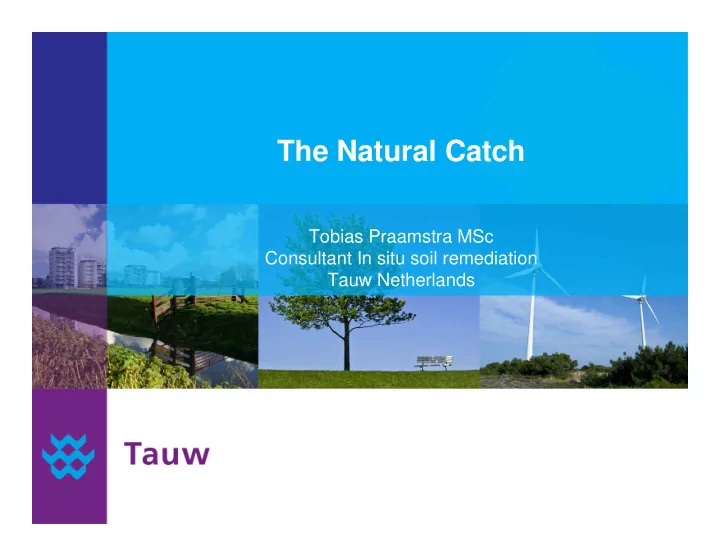

The Natural Catch Tobias Praamstra MSc Consultant In situ soil remediation Tauw Netherlands
Case landfill Kanaalpolder •Philippine •1967- 1977 •500.000 m³ • Chemical waste • On sand
What is the problem? • Large plume • Seapage water on surface level 5 5 • Bad smell 3 3 • Risks 106 106 2 2 11 11 4 4 B08 B08 10 10 9 9 1 1 6 6 12 12 16 16 13 13 15 15 105 105 8 8 • Benzene 7 7 • Ethylbenzene • Monochlorobenzene 104 104 • Vinylchloride • Chloroethane • Dichloroethane • Range: 100 – 10.000 µg/l
Nature as mentor Two chemical landfills, two green principles Stededijkpolder with circular ditch Volgermeerpolder within a peat land
What’s the basic idea of the concept? • Non-conventional approach: use and optimize natural attenuation processes for a finite solution by • Using the landfill and part of soil as (bio)chemical reactor • Drainage of migrating contaminants (catch 1), and • Adsorption by (local) natural (rest) products (catch 2) • Aerobic and photochemical degradation (catch 3)
Combination: Natural Catch Biological & photochemical degradation Biological & photochemical degradation Landfill Landfill O 2 / UV O 2 / UV Discharge purified water Discharge purified water Liner or clay Liner or clay Percolate Percolate Drainage Drainage Peat filter Peat filter Adsorption Adsorption Soil passage Soil passage Nature does the work 1 Rainwater leaching � 2 anaerobic biodegradation � 3 filtering during soil passage � 4 adsorption in peat filter � 5 aerobic and photochemical (bio)degradation in circular canal
Preconditions natural catch • Contaminants which can be adsorbed and/or degraded (biological or photochemical) • Enough space for implementation • Conductive and ‘inert’ adsorption medium • Right dimensions of circular ditch and extraction rate � drainage and hydraulic residence time
Laboratory tests Closed water reservoir Continuous water head Test material Glass pearls Cap with hole Conductivity and adsorption Flow measurement
The field pilots Dimensioning: Green compost • Hydrology • Residence time Peat • Flow • Layer thickness Implementation: • 2 pilots Period: Nov 2009-Jul 2011
Pilot phase 1: physical feasibility Phase 1 •Extraction flow rate •Draining function •Adsorption medium •Water quality Conclusions: • Both ditches drained • Green compost degrades • Flow 2-4 m3/d
Pilot phase 2: processes qualified Phase 2 • Adsorption in peat: contaminants build up gradually • Aerobic biological degradation: DNA analyses (coding genes enzymes) • Oxygen detection surface water: 10 mg/l Vinylchloride Dichloroethane
Pilot phase 3: processes quantified Phase 3 • Final samples of surface- and groundwater • Evaporation measurements • Mass balances: insight in contribution NA-mechanisms 93 – 100 % efficiency Groundwater upstream Natural catch surface water 100000 100000 10000 10000 Concentration (ug/l) Concentration (ug/l) 1000 1000 100 100 10 10 1 1 14-10-2009 22-1-2010 2-5-2010 10-8-2010 18-11-2010 26-2-2011 6-6-2011 14-9-2011 14-10-2009 22-1-2010 2-5-2010 10-8-2010 18-11-2010 26-2-2011 6-6-2011 14-9-2011 Time (date) Time (date) 1,1-Dichloroethane Monochloroethane Vinylchloride 1,1-Dichloorethaan Monochloorethaan Vinylchloride
Pilot phase 3 (2) Lindvall method
Pilot phase 3 (3) Mass balance (fluxes) Q groundwater – Q ditch water = Q sink Q sink = Q degradation + Q evaporation + Q adsorption Component Sink flux Aerobic Evaporation Evaporation measured degradation flux flux (g/d) calculated flux calc lit measured (g/d) (g/d) (g/d) Benzene 0,41 0,44 -0,03 0,0006 1,1-DCA 4,0 3,72 0,28 0,0023 Monochlorobenzene 4,4 4,35 0,05 0,0026 Monochloroethane 52 50,35 1,65 2,65 Vinylchloride 0,12 0,12 0 <0,0016
Conclusions pilot research The natural catch works, if well dimensioned 1 Rainwater leaching � 2 anaerobic biodegradation � 3 filtering during soil passage � 4 adsorption in peat filter � 5 aerobic and photochemical (bio)degradation in circular canal 93 to 100% purification anaerobic leachate (4 & 5) Biological & photochemical degradation Biological & photochemical degradation Landfill Landfill O 2 / UV O 2 / UV Discharge purified water Discharge purified water Liner or clay Liner or clay Percolate Percolate Drainage Drainage Peat filter Peat filter Adsorption Adsorption Soil passage Soil passage Inspired by
Advantages of peat filter within concept • Adsorption and preventing shock loads (buffering) • Creating a habitat for hydrocarbon degrading micro- organisms and eventually for water vegetation • Smaller carbon footprint in relation to activated carbon filter (production, transport) • (Experimental: purification possibility of loaded, contaminated peat with e.g. white-rot fungus) Inspired by
Advantage of total concept Natural Catch No ‘intensive care’ No more non-durable top sealing on, or sheet piling around, chemical landfills, and/or energy consuming pump & treat A finite solution for chemical landfills Landfill as a reactor, not as a sarcophagus Impermeable Impermeable layer layer Extraction Extraction Landfill Landfill Sheet piles Sheet piles Inspired by
Prospects • Feasible for landfills and remote contaminated areas (limited maintenance, one pump on wind or solar energy). Winner Nicole Technology Award • Use of ‘inert’ local and natural adsorption material (modified peat, crushed coffee/cacao been shells, crushed moringa seeds, etc) • Use in hybrid for purification hospital wastewater (instead of high tech purification plant). Winner Award Watership Vallei&Veluwe
Acknowledgements Kanaalpolder Initiators: Thanks to colleagues of Tauw & Witteveen & Bos Pilot management: Erik Labee, Tessa Verschoor, Paul Stook & Tobias Praamstra Sponsored by
Recommend
More recommend